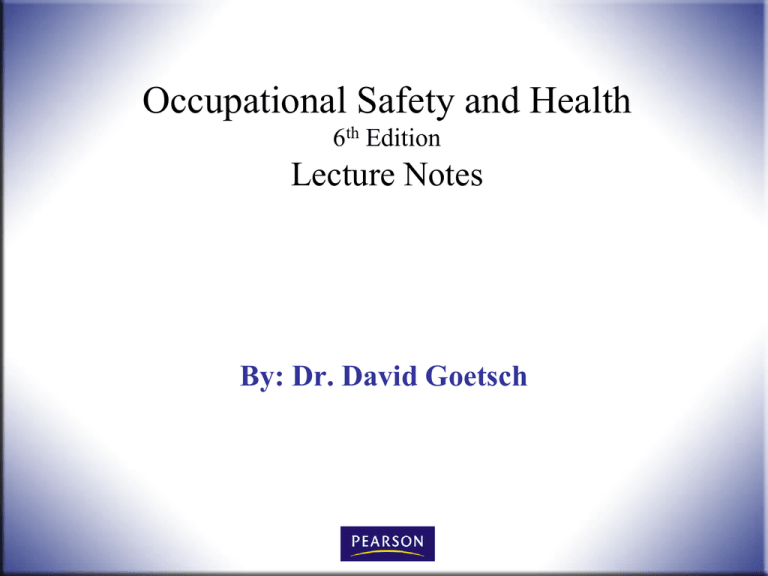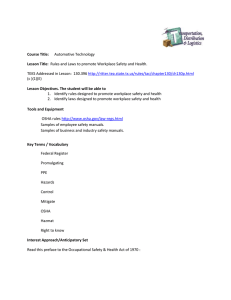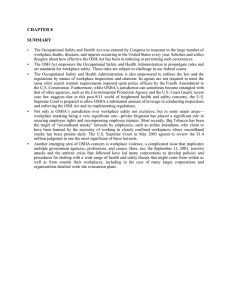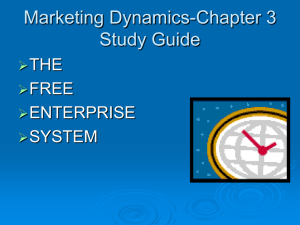
Occupational Safety and Health
6th Edition
Lecture Notes
By: Dr. David Goetsch
Chapter Six
The OSHA Act, Standards, and Liability
The Mission of OSHA
The mission of OSHA is to ensure to the extent possible
that every working person in the United States has a safe
and healthy working environment so that valuable human
resources are preserved and protected. The Department
of Labor breaks down this mission statement further into
the following specific purposes:
Occupational Safety and Health for Technologists, Engineers, and Managers, 6/th ed.
Goetsch
© 2008 Pearson Higher Education,
Upper Saddle River, NJ 07458. • All Rights Reserved.
Purposes of OSHA
•
Encourage employers and employees to reduce workplace hazards
•
Implement new safety and health programs
•
Improve existing safety and health programs
•
Encourage research that will lead to innovative ways of dealing with
workplace safety and health problems
•
Establish the rights of employers and employees regarding the
illnesses and injuries through a system of reporting and record
keeping
•
Establish training programs to increase the number of safety and
health professionals and to continually improve their competence
Occupational Safety and Health for Technologists, Engineers, and Managers, 6/th ed.
Goetsch
© 2008 Pearson Higher Education,
Upper Saddle River, NJ 07458. • All Rights Reserved.
Purposes of OSHA
(Continued)
•
Establish mandatory workplace safety and health standards and
enforce those standards
•
Provide for the development and approval of state-level
workplace safety and health programs
•
Monitor, analyze, and evaluate state-level safety and health
programs
Occupational Safety and Health for Technologists, Engineers, and Managers, 6/th ed.
Goetsch
© 2008 Pearson Higher Education,
Upper Saddle River, NJ 07458. • All Rights Reserved.
Area Covered by OSH Act
The OSH Act covers all employers and all 50 states, the District of
Columbia, Puerto Rico, and all other territories that fall under the
jurisdiction of the U.S. government with the following exceptions:
Persons who are self-employed
Family farms that employ only immediate members of the family
Federal agencies covered by other federal statutes
State and local governments
Occupational Safety and Health for Technologists, Engineers, and Managers, 6/th ed.
Goetsch
© 2008 Pearson Higher Education,
Upper Saddle River, NJ 07458. • All Rights Reserved.
OSHA Standards
OSHA developed standards based on its perception of need
at the request of other federal agencies, state and local
governments, other standard-setting agencies, labor
organizations, or even individual private citizens. OSHA
uses the committee approach for developing standards.
OSHA standing committees are the:
National Advisory Committee on Occupational Safety
Advisory Committee on Construction Safety and Health
Occupational Safety and Health for Technologists, Engineers, and Managers, 6/th ed.
Goetsch
© 2008 Pearson Higher Education,
Upper Saddle River, NJ 07458. • All Rights Reserved.
Types of OSHA Action
OSHA can take three different types of action on standards:
A standard may be:
Adopted
Amended
Revoked
Before any of these actions can be undertaken, OSHA must publish its intentions in
the Federal Register. OSHA has two options for meeting this requirement:
A notice of proposed rule-making
An advance notice of proposed rule-making
Occupational Safety and Health for Technologists, Engineers, and Managers, 6/th ed.
Goetsch
© 2008 Pearson Higher Education,
Upper Saddle River, NJ 07458. • All Rights Reserved.
Effective Date and Appeals
Once the standard has been passed, it becomes effective
on the date prescribed. However, a person who is
opposed to a standard may file an appeal in the court of
appeals serving the geographical region in which the
complainant lives or does business. Appeal paperwork
must be initiated within 60 days of a standard’s approval
Occupational Safety and Health for Technologists, Engineers, and Managers, 6/th ed.
Goetsch
© 2008 Pearson Higher Education,
Upper Saddle River, NJ 07458. • All Rights Reserved.
Temporary Compliance Variances
When an employer is unable to comply with a new
standard immediately but may be able to if given time, a
temporary variance may be requested. OSHA will grant
such a variance up to a maximum of one year. Employers
must demonstrate that they are making a concerted effort
to comply and must take the steps necessary to protect
employees while working toward compliance.
Occupational Safety and Health for Technologists, Engineers, and Managers, 6/th ed.
Goetsch
© 2008 Pearson Higher Education,
Upper Saddle River, NJ 07458. • All Rights Reserved.
Permanent Compliance Variances
Employers who feel that their workplace already
exceeds the requirements of a new standard may request
a permanent variance and must present their evidence to
OSHA for inspection. Employees must be informed of
the application for a variance and notified of their right
to request a hearing.
Occupational Safety and Health for Technologists, Engineers, and Managers, 6/th ed.
Goetsch
© 2008 Pearson Higher Education,
Upper Saddle River, NJ 07458. • All Rights Reserved.
Reporting
OSHA provides for the centralization and systematization of recordkeeping and reporting requirements of the OSH Act to employers of 11
or more workers. Both exempt and nonexempt employers must report
the following types of accidents within eight hours:
Those that result in deaths
Those that result in the hospitalization of three or more employees
Occupational Safety and Health for Technologists, Engineers, and Managers, 6/th ed.
Goetsch
© 2008 Pearson Higher Education,
Upper Saddle River, NJ 07458. • All Rights Reserved.
Reporting
(Continued)
All occupational illnesses and injuries must be reported if they result
in one or more of the following:
Death to one or more workers
One or more days away from work for the employee
Restricted motion or restrictions to the work an employee can do
Loss of consciousness to one or more workers
Transfer of an employee to another job
Medical treatment needed beyond in-house first aid
Appear in Appendix B of the OSH Act
Occupational Safety and Health for Technologists, Engineers, and Managers, 6/th ed.
Goetsch
© 2008 Pearson Higher Education,
Upper Saddle River, NJ 07458. • All Rights Reserved.
OSHA Forms
All records required by OSHA can be maintained
using the following forms:
OSHA Form 300
OSHA Form 301
OSHA Form 300A
Occupational Safety and Health for Technologists, Engineers, and Managers, 6/th ed.
Goetsch
© 2008 Pearson Higher Education,
Upper Saddle River, NJ 07458. • All Rights Reserved.
OSHA Required Posting Materials
Employers are required to post the following material at
locations where employee information is normally
displayed:
OSHA Poster 2203
Summaries of variance requests of all types
Copies of all OSHA citations received for failure to meet
standards
The summary page of OSHA Form 300
Occupational Safety and Health for Technologists, Engineers, and Managers, 6/th ed.
Goetsch
© 2008 Pearson Higher Education,
Upper Saddle River, NJ 07458. • All Rights Reserved.
Authorized Workplace Inspections
OSHA compliance officers are authorized to take the
following action with regard to workplace inspections:
Enter at reasonable times any site, location, or facility where
work is taking place
Inspect at reasonable times any condition, facility, machine,
equipment, materials, and so on
Question in private any employee or other person formally
associated with the company
Occupational Safety and Health for Technologists, Engineers, and Managers, 6/th ed.
Goetsch
© 2008 Pearson Higher Education,
Upper Saddle River, NJ 07458. • All Rights Reserved.
Citations Issued by OSHA
OSHA is empowered to issue citations and/or set penalties. Citations
are for:
Other than serious violations
Serious violations
Willful violations
Repeat violations
Failure to correct prior violations
De minimis violations
Occupational Safety and Health for Technologists, Engineers, and Managers, 6/th ed.
Goetsch
© 2008 Pearson Higher Education,
Upper Saddle River, NJ 07458. • All Rights Reserved.
Employee Appeals
Employees may appeal the following aspects of OSHA’s
decisions regarding their workplace:
The amount of time (abatement period) given an employer to
correct a hazardous condition that has been cited
An employer’s request for an extension of an abatement period
Occupational Safety and Health for Technologists, Engineers, and Managers, 6/th ed.
Goetsch
© 2008 Pearson Higher Education,
Upper Saddle River, NJ 07458. • All Rights Reserved.
Employer Petitions
Employers may petition for:
Modification of abatement
Contest a citation, abatement period, and/or penalty
Occupational Safety and Health for Technologists, Engineers, and Managers, 6/th ed.
Goetsch
© 2008 Pearson Higher Education,
Upper Saddle River, NJ 07458. • All Rights Reserved.
Developing
State Safety and Health Programs
States are allowed to develop their own safety and
health programs. As an incentive, OSHA will fund up
to 50 percent of the cost of operating a state program for
states with approved plans. States may develop
comprehensive plans covering public and private sector
employers or limit their plans to coverage of public
employers only.
Occupational Safety and Health for Technologists, Engineers, and Managers, 6/th ed.
Goetsch
© 2008 Pearson Higher Education,
Upper Saddle River, NJ 07458. • All Rights Reserved.
Setting Standards
and Inspecting for Compliance
In addition to setting standards and inspecting for
compliance, OSHA provides services to help employers
meet the latest safety and health standards. Services are
typically offered at no cost and are intended for smaller
companies, particularly those with especially hazardous
processes or materials.
Occupational Safety and Health for Technologists, Engineers, and Managers, 6/th ed.
Goetsch
© 2008 Pearson Higher Education,
Upper Saddle River, NJ 07458. • All Rights Reserved.
Services Available from OSHA
Services available from OSHA include:
•Consultation
•Volunteer inspection programs
•Training/education
Occupational Safety and Health for Technologists, Engineers, and Managers, 6/th ed.
Goetsch
© 2008 Pearson Higher Education,
Upper Saddle River, NJ 07458. • All Rights Reserved.
Detractors of OSHA
OSHA is not without its detractors. Criticisms of OSHA take
many forms, depending on the perspective of the critic. Some
characterize OSHA as an overbearing bureaucracy with little or
no sensitivity to the needs of employers who are struggling to
survive in a competitive marketplace. Others label OSHA as
timid and claim it does not do enough. At different times and
different places, both points of view have probably been at least
partially accurate.
Occupational Safety and Health for Technologists, Engineers, and Managers, 6/th ed.
Goetsch
© 2008 Pearson Higher Education,
Upper Saddle River, NJ 07458. • All Rights Reserved.
Other Important Federal Agencies
Other federal agencies and organizations that play important roles
with regard to workplace safety and health are:
The National Institute for Occupational Safety and Health, which is a part of
the Department of Health and Human Services
The Occupational Safety and Health Review Commission, which is an
independent board consisting of members appointed by the president and
given quasi-judicial authority to handle contested OSHA citations.
Occupational Safety and Health for Technologists, Engineers, and Managers, 6/th ed.
Goetsch
© 2008 Pearson Higher Education,
Upper Saddle River, NJ 07458. • All Rights Reserved.
Standards and Codes
Standards and codes play an important role in modern safety
and health management and engineering. These written
procedures detail the safe and healthy way to perform jobs,
which, consequently, makes for a safer and healthier workplace.
•A standard is an operational principle, criterion, or requirement—or a
combination of these.
•A code is a set of standards, rules or regulations relating to a specific area.
Occupational Safety and Health for Technologists, Engineers, and Managers, 6/th ed.
Goetsch
© 2008 Pearson Higher Education,
Upper Saddle River, NJ 07458. • All Rights Reserved.
Fundamental Legal Principles
Fundamental legal principles with which safety and
health professionals should be familiar are:
•
Negligence
• Proximate cause
•
Liability
• Willful/reckless conduct
•
Care
• Tort
•
Ability to pay
•
Damages
• Forseeability
Occupational Safety and Health for Technologists, Engineers, and Managers, 6/th ed.
Goetsch
© 2008 Pearson Higher Education,
Upper Saddle River, NJ 07458. • All Rights Reserved.







